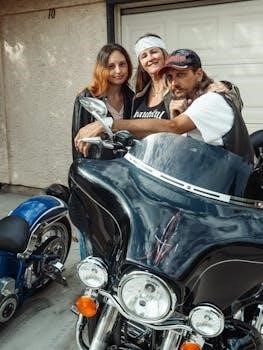Harley Quinn⁚ Overview
Harley Quinn, formerly Dr. Harleen Quinzel, is a central figure in the animated series, which explores her journey after leaving the Joker. Her character evolves from sidekick to an anti-hero, grappling with psychological issues and independence. The series is known for its mature content.
Harley Quinn, originally known as Dr. Harleen Quinzel, is a complex character whose origins are deeply rooted in her tumultuous relationship with the Joker. Initially introduced as his psychiatrist, she became infatuated and transformed into his devoted sidekick. This introduction is crucial to understanding her later evolution. The animated series delves into her struggles with codependency and her journey to establish her own identity separate from the Joker. It is not a simple narrative of good versus evil but rather a nuanced exploration of a character grappling with her past. Harley’s character is marked by her chaotic nature, her sharp wit and surprising moments of vulnerability. The series is definitely not a children’s show. It is intended for mature audiences who can appreciate the dark humor, complex themes, and psychological depth of the character.

Harley Quinn’s Character Evolution
Harley Quinn’s character transformation is central, moving from Joker’s sidekick to an independent anti-hero. The series highlights her struggles with codependency and her journey to self-discovery and empowerment. This evolution is nuanced and complex.
From Sidekick to Anti-Hero
Harley Quinn’s journey is marked by a significant shift from her initial role as the Joker’s sidekick to becoming an anti-hero. This transformation is central to her character arc, showcasing her growth and independence. Initially defined by her relationship with the Joker, Harley gradually breaks free from his influence. She begins to forge her own path, making choices that are often morally ambiguous. This evolution sees her grapple with her past, confront her codependency, and explore her own identity. She forms new relationships, some with fellow villains and others with heroes, further challenging her established role. This transformation presents a complex portrayal of a character seeking self-determination after escaping an abusive relationship. Her actions are not always heroic but they are driven by a desire for autonomy and a need to define herself.

Age Ratings and Parental Guidance
Understanding the age ratings for Harley Quinn’s content is crucial for parents. Both the movie “Birds of Prey” and the animated series have specific ratings due to mature themes, violence, and language, requiring parental awareness.
Birds of Prey Film Rating
The film Birds of Prey (And the Fantabulous Emancipation of One Harley Quinn) received an R-rating in the United States from the MPAA, indicating that it contains material unsuitable for children under 17. This rating is primarily due to strong violence, pervasive language, and some sexual and drug-related content. The British Board of Film Classification (BBFC) has given the movie a 15 rating, meaning no one under the age of 15 can see it, even with an adult. This places it firmly in the category of adult entertainment. Parents should be aware that the film aims for a mature audience and contains intense action sequences and themes that may be unsuitable for younger viewers. The film is designed to be a female-centric action fantasy akin to Deadpool, and its rating reflects its intended audience.
Harley Quinn Animated Series Rating
The Harley Quinn animated series carries an R-rating, signifying it’s intended for mature audiences due to its content. The show delves into mature themes, including violence, strong language, and sexual situations. It’s important to note that the series is not designed for children, and it does not shy away from adult topics. The show’s mature rating is a direct contrast to some other DC animated productions, which aim for a younger audience. The series frequently deals with Harley’s abusive past, codependency issues, and psychological struggles. Parents should be aware of the content before allowing younger viewers to watch. The series’ R-rating ensures that it is not a children’s show but an adult-oriented comedy that explores complex themes.

Content Concerns for Parents
Parents should be aware of several content concerns in Harley Quinn related media, including violence, strong language, sexual content, and substance use. These elements are often present in both animated and live-action adaptations.
Violence and Gore
The portrayal of violence in Harley Quinn’s adaptations is often intense and graphic, featuring scenes of hand-to-hand combat, weapon use, and explosions. The animated series, in particular, does not shy away from showing the consequences of these actions, including blood, visible injuries, and sometimes dismemberment. This level of detail can be disturbing for younger or more sensitive viewers. The violence is often presented in a stylized manner, but it maintains a level of realism that might be unsuitable for children. Birds of Prey, for example, is rated R due to its “strong violence.” Parents should assess their child’s tolerance for graphic content before allowing them to watch any Harley Quinn media. The animated series frequently shows characters being injured, sometimes fatally, and does not shy away from depicting the aftermath of violent confrontations. This is a consistent theme throughout the various adaptations.
Language and Profanity
The language used in Harley Quinn’s stories is often strong and includes frequent use of profanity. Both the animated series and the Birds of Prey film feature characters using explicit language, including swear words and vulgar terms. This is especially true in the animated show where the characters often speak in casual, uncensored tones. The R-rating of Birds of Prey is partly due to the use of strong language throughout the film. The dialogue is designed to reflect the characters’ personalities and the gritty nature of the situations they find themselves in, but can be inappropriate for younger audiences. Parents should be aware that the language is not softened for younger viewers and may include words that some consider offensive. The use of profanity is a consistent element in the mature adaptations of the character and is not sporadic or minimal.
Sexual Content and Nudity
The Harley Quinn animated series and Birds of Prey film contain sexual content and nudity, although not always explicit. The animated series, being R-rated, can include scenes with implied sexual activity and brief instances of pixelated nudity. One example is a villain party where characters are shown making love, albeit in a non-explicit manner. The sexual content often reflects the characters’ liberated and unconventional behavior. The Birds of Prey film also has suggestive scenes and dialogue, as part of its mature themes. While not as graphic as some adult content, both the show and the film include elements that are not suitable for younger audiences. The sexual content is present but not overwhelmingly explicit, aiming to push boundaries and convey adult themes. Parents should be aware that sexual content and nudity is present.
Drug and Alcohol Use
Both the Harley Quinn animated series and the Birds of Prey film include depictions of drug and alcohol use. In the animated series, characters are sometimes shown drinking alcohol, often in social settings or as a coping mechanism. Drug use is also alluded to or depicted, though not always explicitly. The Birds of Prey film similarly features characters consuming alcohol and, in some cases, engaging in drug-related activities; These elements are part of the mature themes and contribute to the gritty and unconventional world of both the series and the film. The use of substances is not glorified but presented as a part of the characters’ lives and their often chaotic circumstances. Parents should be mindful that drug and alcohol use is present in these productions, and consider its suitability for young viewers.

Psychological Themes
The series delves into complex psychological themes, notably Harley’s abusive past with the Joker and her codependency issues. Mental health, female empowerment, and recovery are also significant, adding layers to her character and storyline.
Abusive Relationships and Codependency
Harley Quinn’s narrative heavily features her past abusive relationship with the Joker, a core element explored throughout her animated series. The show portrays the complexities of codependency, where Harley’s identity was heavily tied to the Joker; Her journey involves her struggle to break free from this toxic dynamic. The series highlights the emotional manipulation and psychological damage caused by such relationships, offering a mature look at these issues. Harley’s attempts to establish her independence are a central theme, demonstrating the challenges of overcoming an abusive past. This exploration includes her battles with her own self-worth and her journey towards a healthy sense of self, far removed from the Joker’s influence. The show does not shy away from the difficult and painful realities of such a relationship, making it a prominent theme.
Mental Health Issues
The character of Harley Quinn is intricately linked to her struggles with mental health. Her experiences, particularly her abusive relationship with the Joker, have significantly impacted her psychological well-being. The animated series does not shy away from portraying the effects of trauma, often exploring her erratic behavior and emotional instability. Harley’s journey is marked by her attempts to understand and manage her own mental health, often seeking unconventional methods of coping. The show delves into her underlying issues, including codependency and the development of her own identity. The series portrays these themes in a way that is both insightful and at times, humorous, while acknowledging the serious nature of mental health challenges. It illustrates how past trauma can shape an individual’s present struggles and behaviors.
Female Empowerment
A significant aspect of Harley Quinn’s narrative is her journey toward female empowerment. Initially presented as the Joker’s sidekick, the character evolves into an independent force, taking control of her own destiny. The animated series emphasizes her breaking free from abusive relationships and forming her own identity and a team of female vigilantes. This transformation showcases women standing up against male oppression, forging their own paths and supporting each other. The show promotes the idea of women working together, highlighting their strength and resilience. It explores themes of self-discovery and finding personal power. The depiction of Harley’s emancipation is a central part of her story, symbolizing her empowerment and independence from toxic influences. It presents a narrative that champions female agency and challenges traditional gender roles.
